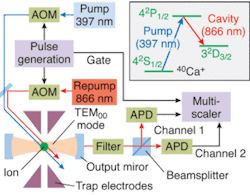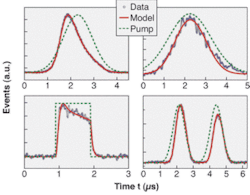Individually controlled single photons can be the basis for quantum bits in quantum logic, and are used as well in fundamental studies such as photon-cavity interactions in quantum electrodynamics. As a result, supplying single photons on demand in a precisely specified direction has become a focus of research.
Scientists at the University of Munich (Munich, Germany) and the Max-Planck Institute for Quantum Optics (Garching, Germany) have demonstrated an experimental setup that generates single photons.1, 2 A single calcium (Ca+) ion trapped in an optical cavity is forced to release one photon into a field mode of that cavity; the photon then exits through the outcoupling mirror (see Fig. 1). The ion is electromagnetically trapped and precisely localized in the optical cavity so that the dipole moment-responsible for the photon to be emitted-couples to a field mode of the cavity.
The photon to be released is obtained by quasi-resonant Raman scattering of 397-nm light (the Ca+ resonance-transition wavelength) by the ion. Raman scattering of a photon by the ion leaves the ion in the metastable 2D3/2 state and yields at the same time an 866-nm Raman photon. With proper adjustment of the resonant optical cavity, that photon can fill a field mode of the cavity. Raman scattering has an almost immediate response; furthermore, Raman scattering in the Ca+ cycle self-terminates because the ion is transferred to a metastable state out of resonance so that no further Raman photons can be generated. With the cavity being tuned to its fundamental (Gaussian) mode and the ion-storage volume matched to the field maximum of the cavity mode, the coherently scattered Raman photon leaves the cavity along its optical axis.
FIGURE 1. Single photons are generated repeatedly using stored Ca+ ions and quasi-resonant Raman scattering. The energy-level diagram underlying the photon-generating process is shown in the inset.
Spontaneous Raman or fluorescence photons can be neglected since the frequency of the pumping laser and the cavity is detuned from the atomic resonance so that no atomic population builds up. The key to the experiment is the coupling of the ion to a field mode of the resonant cavity. But cavity-assisted paraxial Raman photons account for only 8% of all Raman photons; others are emitted into other cavity modes. At the Raman wavelength of 866 nm, ultra-high-Q cavities can be made with losses determined by a weak leaking of radiation, rather than by absorption or scattering (which prevail at shorter wavelengths).
The ion is produced by photoionization, then transferred to the linear radio-frequency quadrupole trap where it is spatially confined to a maximum of about 40 nm from the center of the optical cavity by applying an additional funnel-shaped electrostatic potential along the trap axis. In this way, the ion can be kept for hours.
Pulse shape is imprinted
To induce the Raman scattering, pulses of different shapes and durations up to a few microseconds were deployed, controllable by an acousto-optical modulator. Photon detection was provided by an avalanche photodiode after spectral and spatial filtering. The single-photon detection efficiency reached 4.6%. Photons were counted using a multiscaler with 2-ns resolution that was triggered by the Raman pumping laser. In this way, Raman-photon arrival could be recorded statistically as a function of time (see Fig. 2).
The authors interpret those results as an imprinting of the arbitrary temporal shape of a coherent pumping pulse onto the single-photon waveform. The key is that the pumping multiphoton pulse is prepared coherently and that coherence is transferred via cavity quantum electrodynamics to the coherently emerging single pulse. As in any elementary-particle detection, however, individual “photon shape” (that is the square of its field amplitude in space and time) manifests itself in photon-arrival statistics.
The detector efficiency of 4.6%, together with the 8% efficiency for coherent single photons, provides a coherent single Raman photon only in about 0.4% of all cycles. Currently, the importance of the experiment stems from the proof that only one coherent photon is generated at a time and that photon distribution in time follows that of the pumping pulse so that interference experiments with “engineered” photons become possible.
Future applications include tests of quantum repeaters for single-photon communication lines, interference experiments with single photons having controlled coherence length, and the deterministic generation of single photons necessary to perform complex quantum-information protocols.
REFERENCES
1. M. Keller et al., New J. Physics 6(2004) 95; online at www.njp.org.
2. M. Keller et al., Nature 431, 1075 (Oct. 28, 2004).

